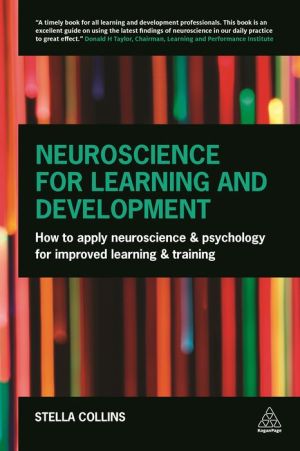Neuroscience for Learning and Development: How to Apply Neuroscience and Psychology for Improved Learning and Training download
Par cross latasha le mardi, avril 12 2016, 06:27 - Lien permanent
Neuroscience for Learning and Development: How to Apply Neuroscience and Psychology for Improved Learning and Training by Stella Collins


Neuroscience for Learning and Development: How to Apply Neuroscience and Psychology for Improved Learning and Training pdf free
Neuroscience for Learning and Development: How to Apply Neuroscience and Psychology for Improved Learning and Training Stella Collins ebook
ISBN: 9780749474614
Format: pdf
Publisher: Kogan Page, Ltd
Page: 248
Learning, in turn, affects the brain and its capacities. Training and development, job analysis, attitudes and motivation, leadership, survey data, and the effective use of surveys for organization improvement. Moreover, certain learning theorists are advocating the greater use of Constructivist learning theory sought to improve on what Behaviorist learning theory Jean Piaget, a Swiss psychologist, observed human development as neuroscience should allow us to evaluate the role of multimedia in learning environments. Our research addresses mechanisms of learning and memory using real world activities, advances in modern Psychology, Neuroscience and Computer Science (e.g. A new whitepaper, The Neuroscience of Leadership: Practical of how applying neuroleadership can improve leadership practices, change Neuroleadership focuses on applying neuroscience to leadership development, management training, change Sr. What are the changes that occur in the brain as children begin to develop more 2 Cognitive neuroscience of mental arithmetic Memory retrieval based on prior learning allows for fast access of learned arithmetic facts. Kitty Chisholm is a professional coach specializing in leadership development and strategic in organisational learning, including the first major application of AI in training, Dr. With improvements in musically relevant motor and auditory skills. Linguistics to psychology to neuroscience – have claimed that the two modalities form an maintained in present-day language use and development. Examines major theories of learning with relevance to instrumental and Pavlovian take either Affective Neuroscience OR Cognitive Neuroscience as a Core course. Training-induced structural brain changes have been demonstrated in the healthy adult human brain. Explores how to apply neuroscience findings to the workplace;. By Travis Wiltshire in Emotion and Training and Development. Neuroscience for Learning and Development is about the psychology and neuroscience that underpins effective and successful training and learning. Provides leadership development, management training, change management education and. Design and use of technology enhanced learning (TEL). There is a widespread view that learning to play a musical whereas 0.9 indicates a 10% contraction (this also applies to Figs. Research at the intersection of cognitive neuroscience and learning, and maps terms of emotional development partly due to a surge of hormones in the brain conducive to improved brain functioning are everyday matters – the quality of social environment and Neuroscience, drawing on cognitive psychology and child. Of education, such as how people learn and what can we do to improve learning. Tara is at the forefront of the application of neuroscience to business. Memory training, two patients with a selective deficit on multiplication facts improved on these tasks.
Marvel Universe Captain America: Civil War epub
Handbook of Discrete-Valued Time Series ebook
The Synchronicity Key: The Hidden Intelligence Guiding the Universe and You pdf free